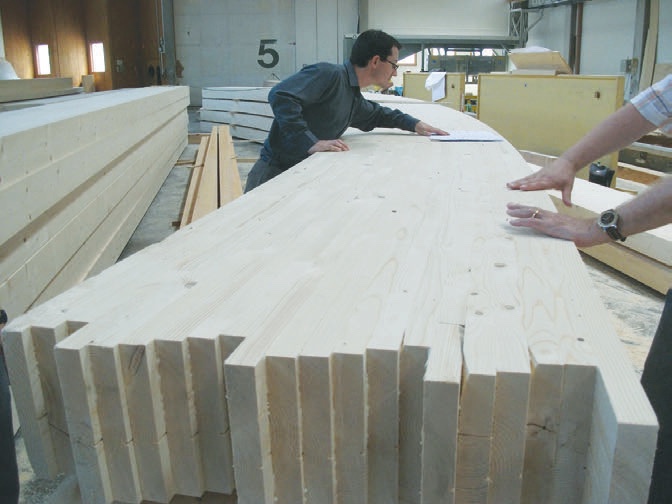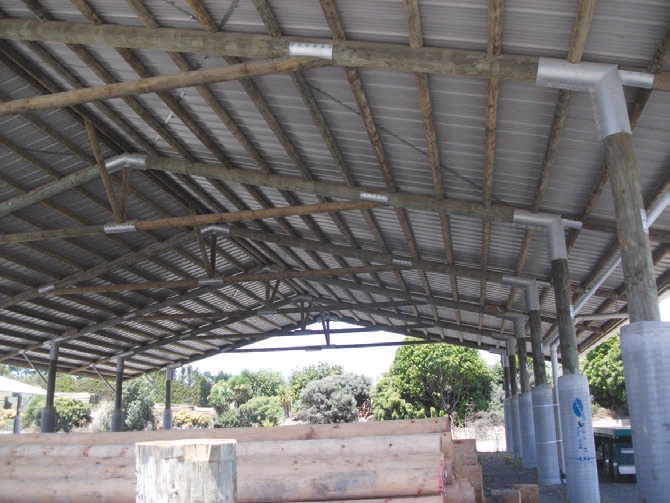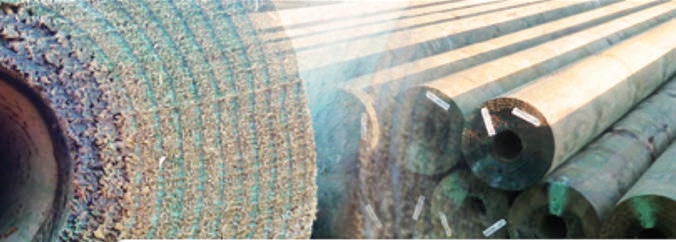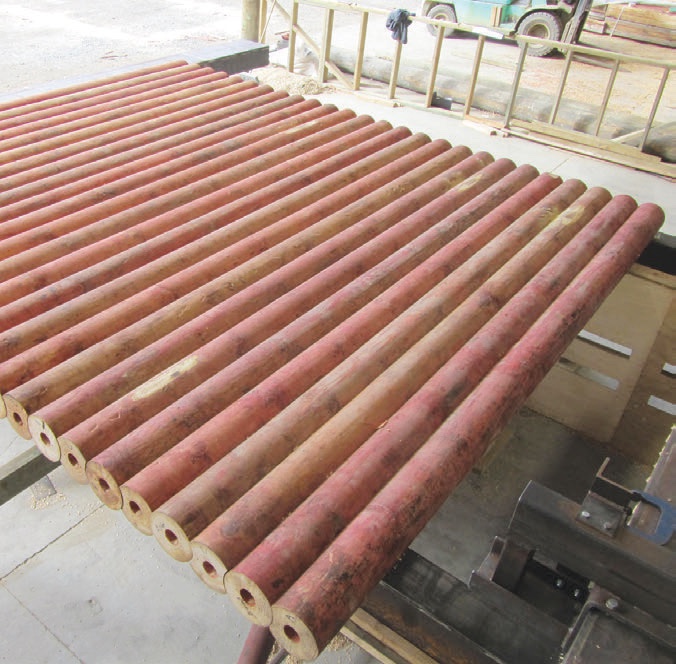Adding value by thinking outside the square
Michael Cambridge, New Zealand Tree Grower February 2014.
The NZFFA conference in Blenheim will feature a session on using wood in cities. We will be looking at some of the new ways to use wood to compete with the steel and concrete normally used in cities. These new methods are bringing wood back into fashion in Europe as well as New Zealand.
We normally think of sawmills to add value to our logs. The recent decision to close the Tachikawa sawmill in Rotorua highlights how tight the margins are for sawmillers. Sawing round logs into square timber produces large amounts of low-value waste material. Over 10 per cent of the log becomes sawdust and shavings, and 30 per cent is turned into chip. There are large variations in the strength of the sawn timber, depending on knots and different parts of the tree. The high strength wood is suitable for house framing, but the low strength wood needs to have the knots removed, then finger jointed and glued to create valuable timber.
Adding value to timber
Glulam or glue laminated wood is common in Europe. The massive curved laminated beams shown in the photograph have the strongest wood glued on the outside of the beam. These beams are twice as strong as steel on a strength-to-weight basis.
Another way to use the different strength grades of wood is to glue them into large panels. Cross laminated timber, where boards are glued together in layers like plywood, has become a very popular system in Europe. Panels up to 15 metres by three metres are made for floors and walls. Openings for doors and windows are precisely cut and the panels are lifted into place with a crane. It is common in Europe for a two-storey house to be put together in one day using cross laminated timber panels. The first cross laminated timber plant in the southern hemisphere started operating in Nelson relatively recently.

Peeling logs for plywood
Another way to process logs is to peel them for plywood. Peeling produces no sawdust and there is only a small amount of waste from trimmings and the peeler core. Much of the wood we send to China is peeled for construction ply. They can use quite small diameter logs because the peeler core is only 35 millimetres, the size of a broom handle.
Nelson Pine peels 200,000 tonnes of logs a year for laminated veneer lumber or LVL. This is different from plywood because all the veneers are glued parallel to each other to create high-strength timber beams up to 18 metres long. The 75 millimetre peeler core is the weakest part of the log and is normally used for boiler fuel. The veneer sheets are all strength tested so that the strongest are used for the outer layers.
Pine logs for LVL receive a good premium if the logs meet the required strength grade after they are acoustically tested. A range of timber products can be produced which are consistent in quality and much stronger than the original wood. Consistent strength makes LVL popular with engineers who can then combine it with steel and concrete systems to get the best value from each material.
Hollow timber poles
Natural timber poles have been used for centuries where strength and light weight are required. The English navy had access to the largest trees in North America and New Zealand, so they had the biggest masts for the largest sailing ships to rule the seas. Care was taken not to damage the outer layers of wood when preparing the masts because this is where the strongest wood is.

Poles are widely used for simple low cost storage buildings, wharf piles, power poles and foundations. The poles can be machined to a constant diameter to provide a neat timber structure such as the pole storage shed in the photograph. The constant diameter poles are called unilogs. These unilogs can have exterior connections to join the trusses to the posts. Small notches are machined into the top of the trusses so that the purlins fit neatly. The hollow poles mean that the newer sheds can have hidden connections.
Unilogs can be used for high-precision structures such as cellphone towers. The top of the tower must not sway in the wind, so the structure has to be very strong. The 40-metre tower shown in the photograph weighs just 1.8 tonnes, a benefit of the high strength-to-weight ratio of poles. Two men installed this tower in a day without a crane.

Auckland timber engineer, Mark Batchelar, came up with the idea of putting a hole down the centre of the pole so that poles could be connected internally. This is more easily said than done, but TTT Products Ltd has perfected a system of putting a hole down the centre of poles up to 18 metres long.
Removing the core wood first has many advantages −
- Speeds up the drying process
- Allows treatment to fully penetrate the wood from the inside as well as the outside
- Removes stress from the log so that it dries evenly with no large cracks
- Reduces twist from spiral grain
- Up to a third of the diameter can be removed with little effect on strength, so the strength-to-weight ratio is increased.
The hollow poles are particularly good for foundation piles. A high pressure water jet can be inserted down the pole to make them easy to vibrate into the ground. Piles can be easily joined with a metal sleeve to reach the required depth. Untreated wood can be used if the bottom pile is permanently below water level. Grout can be injected instead of water to put a bulb of concrete at the base of the pole.

Three different grades of poles are produced. Those with constant diameter are called unilogs, smooth tapered poles are called multipoles, and poles for foundations which have just been debarked are called uglies.
Computer controlled machines are used to notch the ends of poles so they fit neatly together without using glue. They can also be used to carve the poles. Poles then become a very sophisticated and attractive building system. Round poles look more natural than sawn timber and services can be hidden in the hollow core of the poles. Round poles also perform very well in a fire. This really is world-leading technology.
New Zealand’s greenest building
The $15 million Tuhoe building being built at Taneatua, near Whakatane, is the most ambitious sustainable building project planned for New Zealand. It aims to meet the living building challenge standard where 20 aspects of the building are judged during construction and after 12 months of operation. The carbon footprint is one of those items judged. The good news for farm foresters is that it is being built mainly of wood. The wood building system includes some world-leading innovation. Hollow timber piles were used for the foundations. The piles were treated with micronized copper because using copper, chromium and arsenic treatment is not acceptable for this challenge.
The most innovative aspect of this building is how the floors and walls have been built with hollow timber poles pressed together. The poles are accurately notched so that they cannot slide against each other. Steel rods are fed down some of the holes to connect to the beams and foundations. The logs are also used vertically to make cost-effective rocking shear walls, which perform very well in earthquakes.
Wood coming back into fashion

I have visited Europe six times to study their wood building systems and have seen a range of amazing buildings. I visited the factory in Germany which makes most of the world’s largest timber structure. Wood is very much in fashion in central Europe because of inspiring buildings using glulam, cross laminated timber, LVL and accurate prefabrication in a factory. Europeans are very aware of the carbon footprint and energy efficiency of wood buildings. They also understand the health benefits of living with wood. This makes wood the preferred building material in many parts of Europe.
There have been many recent inspiring wood buildings in New Zealand highlighted by the timber design awards. Glulam, LVL and now cross laminated timber give architects and engineers the chance to use wood in larger buildings where it could not be considered a few years ago. The hollow timber pole technology helps put New Zealand up with the best when it comes to sustainable and green buildings.
Spruce is the dominant species in Europe, as radiata pine dominates in New Zealand. When wood comes back into fashion, it opens up the market for a range of species. Wood gets used on more of the exposed surfaces where the characteristics of the different species are appreciated. This is good news for farm foresters who like growing a range of species.
I have farmed merinos for most of my working life and have seen how the determined efforts of growers have brought merino back into fashion. We can do the same with wood when we have belief in our product and produce it in a form that inspires the consumer.
What does it mean for farm foresters?
There will always be sawmills and a market for sawn timber. High export log prices are squeezing the margins for sawmillers and the local log price is often lower than the export price. Good margins are being paid for high-strength logs for LVL production with small end diameter down to 20 centimetres.
Rotary peeling is a very efficient way to turn a log into building material as the only waste is the low strength core wood. All the LVL can be turned into quite high-value products. Good prices have always been paid for pole material. The hollow timber pole innovation has the potential to greatly increase the market for poles.
Come to the forestry conference
At the NZFFA conference in Blenheim in April you will have the chance to hear inspiring speakers talk about ways to bring wood back into fashion in cities. The presentation on 12 April includes −
- Di Lucas a landscape architect with Lucas Associates who will talk about the Christchurch landscape after the earthquakes and the need for cost-effective foundations
- John Reelick of TTT Products Ltd talking about innovative hollow timber piles being used in Christchurch
- Jason Guiver from Nelson Pine on the production of LVL from Marlborough’s high strength wood and its use in Christchurch rebuild
- Sam Leslie from Xlam NZ Ltd with examples of cross laminated timber buildings in New Zealand
- Allan Laurie of Laurie Forestry on how New Zealand logs are being processed and used to build multi-storey apartment buildings in China.
A conference registration form is included in this issue of Tree Grower. We look forward to seeing you in Blenheim.
Michael Cambridge is President of the Marlborough Forest Industry Association.

 Farm Forestry New Zealand
Farm Forestry New Zealand